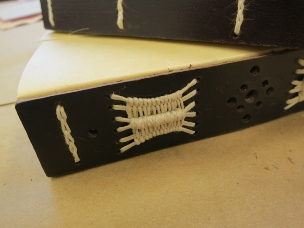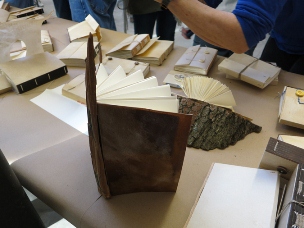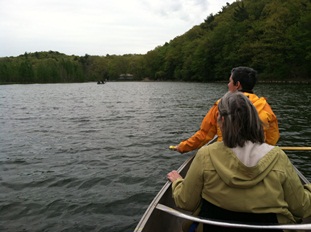Monday, May 20, 2013
 Reporting from Oxbow School of the Arts in Saugatuck, Michigan, Giselle Simon, here, attending Paper and Book Intensive, 2013. We got off to rousing start with a fantastic line up: Jeff Altepeter, binder and instructor from North Bennett St. School taught a technical leather paring class. Bernie Vinzani, Papermaking faculty from the University of Machias, Maine covered papermaking techniques involving watermarks and sheet formation. Sarah Bryant, printer from the UK covered pressure printing on the letterpress. Paula Jull, book artist and instructor from Idaho presented a page design class. Adam Larsson, Conservator from Sweden, shared with us 14th C. limp vellum structures from the National Library in Uppsala.
Reporting from Oxbow School of the Arts in Saugatuck, Michigan, Giselle Simon, here, attending Paper and Book Intensive, 2013. We got off to rousing start with a fantastic line up: Jeff Altepeter, binder and instructor from North Bennett St. School taught a technical leather paring class. Bernie Vinzani, Papermaking faculty from the University of Machias, Maine covered papermaking techniques involving watermarks and sheet formation. Sarah Bryant, printer from the UK covered pressure printing on the letterpress. Paula Jull, book artist and instructor from Idaho presented a page design class. Adam Larsson, Conservator from Sweden, shared with us 14th C. limp vellum structures from the National Library in Uppsala.
 Larsson’s class was of particular interest to me, as we saw a version of historical long and link stitches originating from Northern Europe. We recreated two particular bindings from the Uppsala collection, these being manuscripts. The structures featured a stiff spine piece sewn with the text, which was usually carved horn, leather or parchment. The spine piece protected the cover and allowed for bookmarks of thread or tawed skin to be tied to the linking stitches at the head of the book. Decorative elements such as colored tawed
Larsson’s class was of particular interest to me, as we saw a version of historical long and link stitches originating from Northern Europe. We recreated two particular bindings from the Uppsala collection, these being manuscripts. The structures featured a stiff spine piece sewn with the text, which was usually carved horn, leather or parchment. The spine piece protected the cover and allowed for bookmarks of thread or tawed skin to be tied to the linking stitches at the head of the book. Decorative elements such as colored tawed  skin or silver sheets (like foil) were placed behind cut outs in the spine. The long stitching was woven with additional thread after sewing to add protection to the stitches, but also added a beautiful aesthetic touch. There was a close connection with Italian paper case structures, but clearly these bindings have a look and feel all their own, each being relatively the same size (approximately 9 inches in height), a stiff spine piece, and some type of horn or parchment “button” closure and all link or long stitch.
skin or silver sheets (like foil) were placed behind cut outs in the spine. The long stitching was woven with additional thread after sewing to add protection to the stitches, but also added a beautiful aesthetic touch. There was a close connection with Italian paper case structures, but clearly these bindings have a look and feel all their own, each being relatively the same size (approximately 9 inches in height), a stiff spine piece, and some type of horn or parchment “button” closure and all link or long stitch.
 During the final day, Larsson encouraged the class to experiment with other materials for the spine piece, with some participants finding drift wood from the nearby Oxbow lagoon. The sewing holes, which were drilled into the wood and text attached to it by the sewing (linking and long stitches), created a modern twist to the Medieval structure.
During the final day, Larsson encouraged the class to experiment with other materials for the spine piece, with some participants finding drift wood from the nearby Oxbow lagoon. The sewing holes, which were drilled into the wood and text attached to it by the sewing (linking and long stitches), created a modern twist to the Medieval structure.
 After a brief “day-off” to prepare the studios for the next session (plus a canoe trip!), we look forward to another week of paper, book and print…intensive!
After a brief “day-off” to prepare the studios for the next session (plus a canoe trip!), we look forward to another week of paper, book and print…intensive!